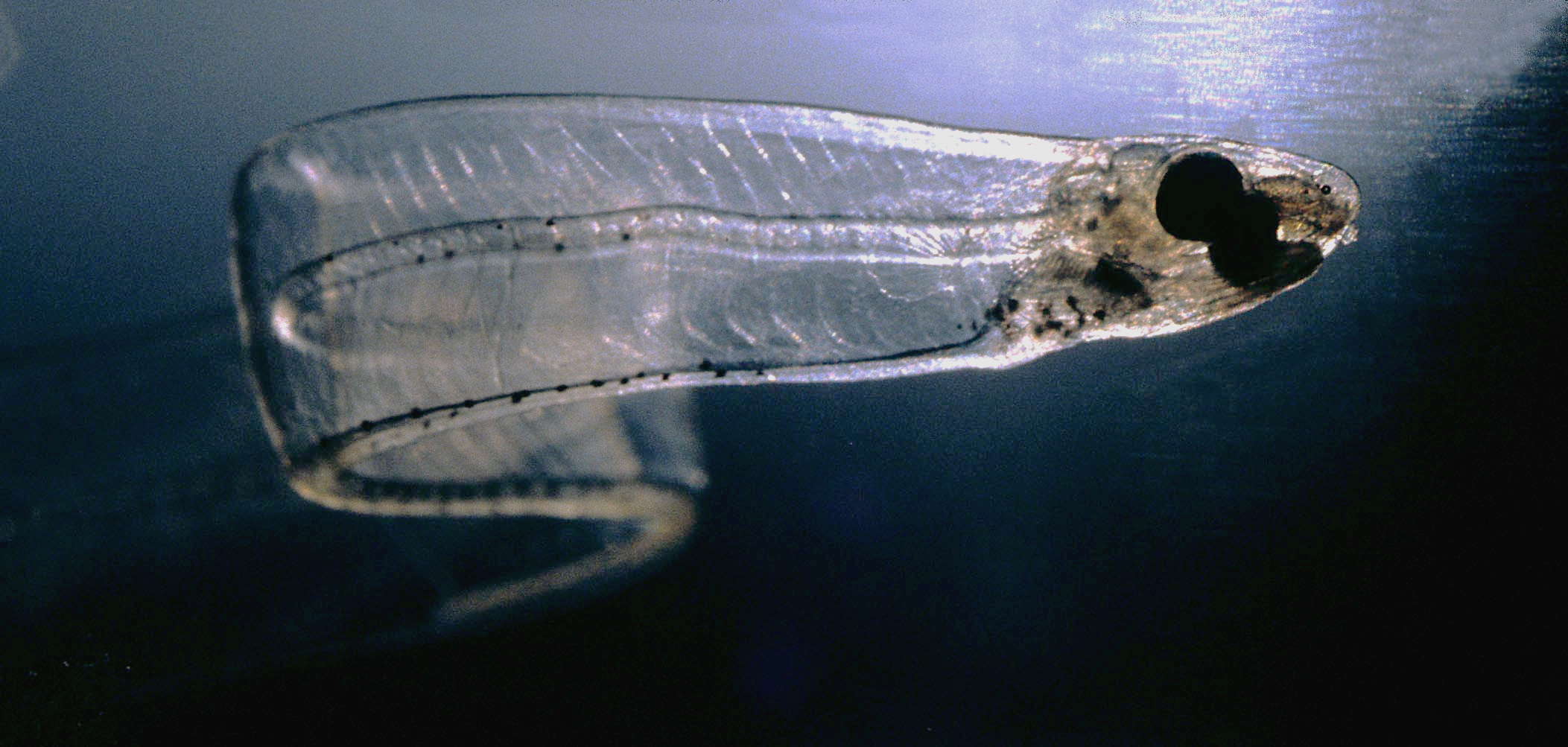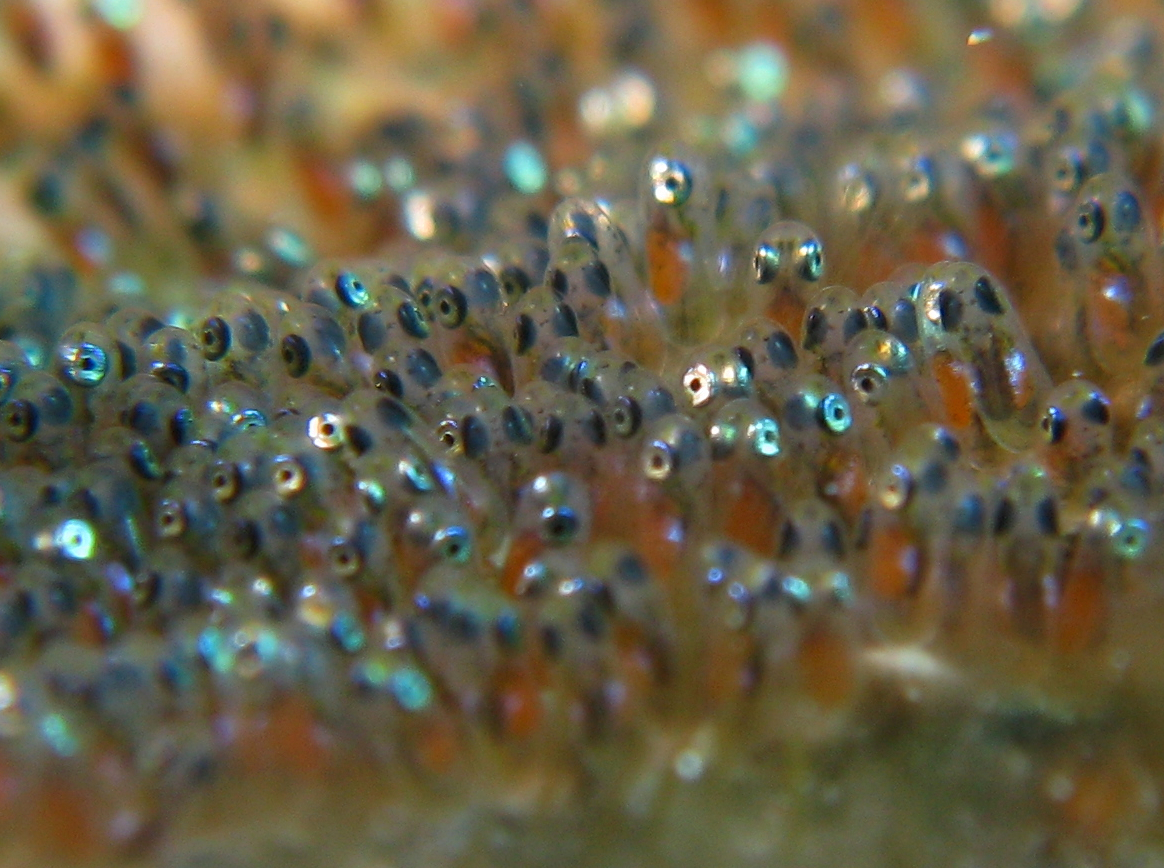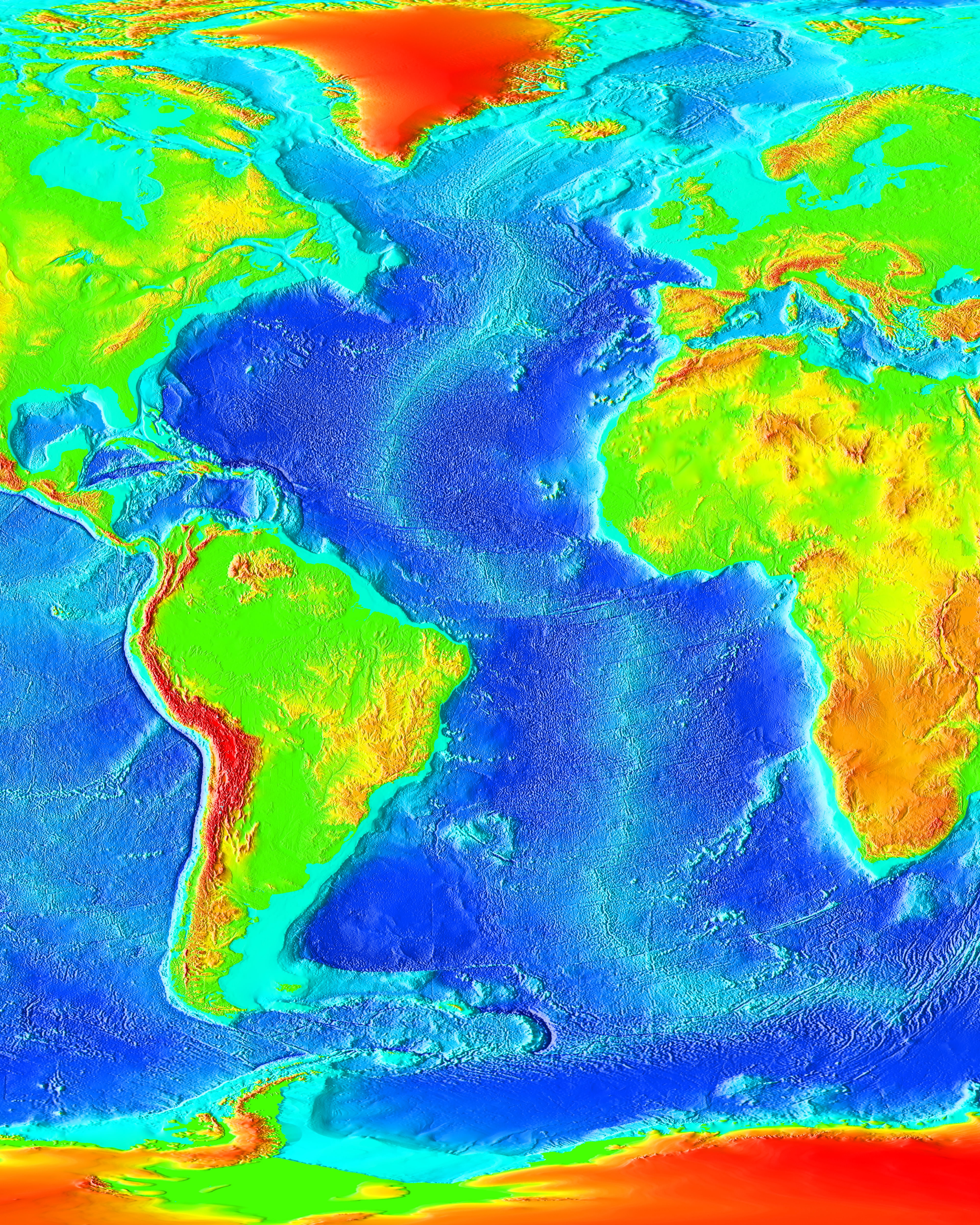|
Eel Life History
Eels are any of several long, thin, bony fishes of the order Anguilliformes. They have a catadromous life cycle, that is: at different stages of development migrating between inland waterways and the deep ocean. Because fishermen never caught anything they recognized as young eels, the life cycle of the eel was long a mystery. Of particular interest has been the search for the spawning grounds for the various species of eels, and identifying the population impacts of different stages of the life cycle. Past studies of eels The European eel (''Anguilla anguilla'') is the one most familiar to Western scientists, beginning with Aristotle, who wrote the earliest known inquiry into the natural history of eels. He speculated that they were born of "earth worms", which he believed were formed of mud, growing from the "guts of wet soil" rather than through sexual reproduction. Many centuries passed before scientists were able to demonstrate that such spontaneous generation does not occur. ... [...More Info...] [...Related Items...] OR: [Wikipedia] [Google] [Baidu] |
Leptocephalus
A leptocephalus (meaning "slim head") is the flat and Transparency (optics), transparent larva of eels and other members of the superorder Elopomorpha. This is one of the most diverse groups of teleosts, containing 801 species in 4 orders, 24 families, and 156 genera. This group is thought to have arisen in the Cretaceous period over 140 million years ago.Inuoe, Jun, M. Miya, et al. “Mitogenomic evidence for the monophyly of elopomorph fishes (Teleostei) and the evolutionary origin of the leptocephalus larva.” Molecular Phylogenetics and Evolution 32 (2004): 274-286. Web. 2 Nov. 2012. Fishes with a leptocephalus larval stage include the most familiar eels such as the conger, moray eel, and garden eel as well as members of the family Anguillidae, plus more than 10 other families of lesser-known types of marine eels. These are all true eels of the order Anguilliformes. Leptocephali of eight species of eels from the South Atlantic Ocean were described by Meyer-Rochow The fi ... [...More Info...] [...Related Items...] OR: [Wikipedia] [Google] [Baidu] |
Spawn (biology)
Spawn is the eggs and sperm released or deposited into water by aquatic animals. As a verb, ''to spawn'' refers to the process of freely releasing eggs and sperm into a body of water (fresh or marine); the physical act is known as spawning. The vast majority of aquatic and amphibious animals reproduce through spawning. These include the following groups: * Bony fishes * Crustaceans (such as crabs, shrimps, etc.) *Mollusks (such as oysters, octopus, squid) *Echinoderms (such as sea urchins, sea stars, sea cucumbers, etc.) * Amphibians (such as frogs, toads, salamanders, newts) * Aquatic insects (such as dragonflies, mayflies, mosquitoes) *Coral, which are living colonies of tiny, aquatic organisms—not plants, as they are sometimes perceived to be. Corals, while appearing sedentary or botanical by nature, actually spawn by releasing clouds of sperm and egg cells into the water column, where the two mix. As a general rule, aquatic or semiaquatic reptiles, birds, ... [...More Info...] [...Related Items...] OR: [Wikipedia] [Google] [Baidu] |
Bermuda
Bermuda is a British Overseas Territories, British Overseas Territory in the Atlantic Ocean, North Atlantic Ocean. The closest land outside the territory is in the American state of North Carolina, about to the west-northwest. Bermuda is an archipelago consisting of List of islands of Bermuda, 181 islands, although the most significant islands are connected by bridges and appear to form one landmass. It has a land area of . Bermuda has a tropical climate, with warm winters and hot summers. Its climate also exhibits Oceanic climate, oceanic features similar to other coastal areas in the Northern Hemisphere with warm, moist air from the ocean ensuring relatively high humidity and stabilising temperatures. Bermuda is prone to severe weather from Westerlies#Interaction with tropical cyclones, recurving tropical cyclones; however, it receives some protection from a coral reef and its position north of the Main Development Region, which limits the direction and severity of approach ... [...More Info...] [...Related Items...] OR: [Wikipedia] [Google] [Baidu] |
Sargasso Sea
The Sargasso Sea () is a region of the Atlantic Ocean bounded by four currents forming an ocean gyre. Unlike all other regions called seas, it is the only one without land boundaries. It is distinguished from other parts of the Atlantic Ocean by its characteristic brown '' Sargassum'' seaweed and often calm blue water. The sea is bounded on the west by the Gulf Stream, on the north by the North Atlantic Current, on the east by the Canary Current, and on the south by the North Atlantic Equatorial Current, the four together forming a clockwise-circulating system of ocean currents termed the North Atlantic Gyre. It lies between 20° and 35° north and 40° and 70° west and is approximately wide by long. Bermuda is near the western fringes of the sea. While all of the above currents deposit marine plants and refuse into the sea, ocean water in the Sargasso Sea is distinctive for its deep blue color and exceptional clarity, with underwater visibility of up to . It is als ... [...More Info...] [...Related Items...] OR: [Wikipedia] [Google] [Baidu] |
Atlantic Ocean
The Atlantic Ocean is the second largest of the world's five borders of the oceans, oceanic divisions, with an area of about . It covers approximately 17% of Earth#Surface, Earth's surface and about 24% of its water surface area. During the Age of Discovery, it was known for separating the New World of the Americas (North America and South America) from the Old World of Afro-Eurasia (Africa, Asia, and Europe). Through its separation of Afro-Eurasia from the Americas, the Atlantic Ocean has played a central role in the development of human society, globalization, and the histories of many nations. While the Norse colonization of North America, Norse were the first known humans to cross the Atlantic, it was the expedition of Christopher Columbus in 1492 that proved to be the most consequential. Columbus's expedition ushered in an Age of Discovery, age of exploration and colonization of the Americas by European powers, most notably Portuguese Empire, Portugal, Spanish Empire, Sp ... [...More Info...] [...Related Items...] OR: [Wikipedia] [Google] [Baidu] |
Carlsberg Foundation
Carlsberg Foundation () is a not-for-profit organization that was founded by J. C. Jacobsen in 1876, by allocating some of his shares in the Carlsberg Brewery to fund and operate the Carlsberg Laboratory and the Museum of National History at Frederiksborg Palace. The foundation has since expanded to fund scientific research, and via the Tuborg Foundation to fund social works. it owned 30.3% of the shares in Carlsberg Group and controlled 74.2% of the voting power. History The foundation was started to run Carlsberg Laboratory. To finance its works the foundation received a portion of shares in Carlsberg Brewery. J.C. Jacobsen's wish was to create a foundation with firm obligations to the natural sciences and direct responsibility for the running of a corporate enterprise. In 1878 the foundation started to manage and fund the Museum of National History at Frederiksborg Palace. In 1887 after the death of J. C. Jacobsen the foundation inherited the remaining shares in the brew ... [...More Info...] [...Related Items...] OR: [Wikipedia] [Google] [Baidu] |
Dana Expeditions
The Dana expeditions were four Danish research expeditions from 1920 to 1930. The first two were undertaken by the ''Dana I'' and the third by the ''Dana II''. They were funded in part by the Carlsberg Foundation and led by Johannes Schmidt. The first three expeditions took place from 1920 to 1922 and the fourth and final was from 1928 to 1930. They centered around investigating the breeding of eels. The first two expeditions allowed Schmidt to prove his theory that European eels migrate to the Sargasso Sea to spawn. The final expedition traveled to the Indian Ocean and gathered numerous samples. First expeditions (1920–1922) Planning From 1920 to 1922, ''Dana'' undertook a series of three expeditions that were led by the marine biologist Johannes Schmidt. Schmidt and C. F. Dreschel had first proposed an expedition that would explore the deep sea of the Atlantic Ocean in 1916. Although the two men originally envisioned a single large expedition, in January 1917 Schmi ... [...More Info...] [...Related Items...] OR: [Wikipedia] [Google] [Baidu] |
North Atlantic
The Atlantic Ocean is the second largest of the world's five oceanic divisions, with an area of about . It covers approximately 17% of Earth's surface and about 24% of its water surface area. During the Age of Discovery, it was known for separating the New World of the Americas (North America and South America) from the Old World of Afro-Eurasia (Africa, Asia, and Europe). Through its separation of Afro-Eurasia from the Americas, the Atlantic Ocean has played a central role in the development of human society, globalization, and the histories of many nations. While the Norse were the first known humans to cross the Atlantic, it was the expedition of Christopher Columbus in 1492 that proved to be the most consequential. Columbus's expedition ushered in an age of exploration and colonization of the Americas by European powers, most notably Portugal, Spain, France, and the United Kingdom. From the 16th to 19th centuries, the Atlantic Ocean was the center of both an epo ... [...More Info...] [...Related Items...] OR: [Wikipedia] [Google] [Baidu] |
Johannes Schmidt (biologist)
Ernst Johannes Schmidt (2 January 1877 – 21 February 1933) was a Danish biologist credited with discovering in 1920 that European eels migrate to the Sargasso Sea to spawn. Before this people in North America and Europe had wondered where the small glass eels, or elvers, came from. Biography Schmidt was born at Jægerspris, Denmark, son of Ernst Schmidt and Camilla Ellen Sophie Schmidt (born Kjeldall and sister to the chemist Johan Kjeldahl). Schmidt began his studies of natural history at the University of Copenhagen under professor of botany Eugen Warming (1841–1924), and obtained an MS degree in biology in 1898. He obtained a grant from the Carlsberg Foundation to study the flora of the coastal areas of Ko Chang in then Siam, including both mangrove trees and microalgae. He made his doctoral thesis in biology and botany, on shoot architecture of mangrove trees and Eugen Warming served as faculty opponent in October 1903. Schmidt then more or less switched to marine ... [...More Info...] [...Related Items...] OR: [Wikipedia] [Google] [Baidu] |
Denmark
Denmark is a Nordic countries, Nordic country in Northern Europe. It is the metropole and most populous constituent of the Kingdom of Denmark,, . also known as the Danish Realm, a constitutionally unitary state that includes the Autonomous administrative division, autonomous territories of the Faroe Islands and Greenland in the north Atlantic Ocean.* * * Metropolitan Denmark, also called "continental Denmark" or "Denmark proper", consists of the northern Jutland peninsula and an archipelago of 406 islands. It is the southernmost of the Scandinavian countries, lying southwest of Sweden, south of Norway, and north of Germany, with which it shares a short border. Denmark proper is situated between the North Sea to the west and the Baltic Sea to the east.The island of Bornholm is offset to the east of the rest of the country, in the Baltic Sea. The Kingdom of Denmark, including the Faroe Islands and Greenland, has roughly List of islands of Denmark, 1,400 islands greater than in ... [...More Info...] [...Related Items...] OR: [Wikipedia] [Google] [Baidu] |
Rostrata
Rostratus (masculine), rostrata (feminine) or rostratum (neuter) is a Latin adjective meaning "beaked, curved, hooked, with a crooked point, or with a curved front". In marine warfare, the term ''beak'' (''rostrum'') referred to the ram bows on warships, which were metal or metal-covered beams projecting from ships' bows, used to pierce enemy vessels by ramming. Roman usage Columna rostrata (Rostral column) After the Battle of Mylae in 260 BC during the First Punic War, a ''columna rostrata'' (a victory column), was placed in the Roman Forum in honour of Gaius Duilius. It was so called because it was adorned with the beaks (ram bows) of the captured Carthaginian vessels. The ''columna rostrata'' became a favourite site for speeches. Corona rostrata A ''corona rostrata'' was a golden wreath, decorated with small golden prow and beak of a ship. These were awarded to commanders who were victorious in naval warfare. Modern usage In modern usage the adjective is used in Linna ... [...More Info...] [...Related Items...] OR: [Wikipedia] [Google] [Baidu] |








